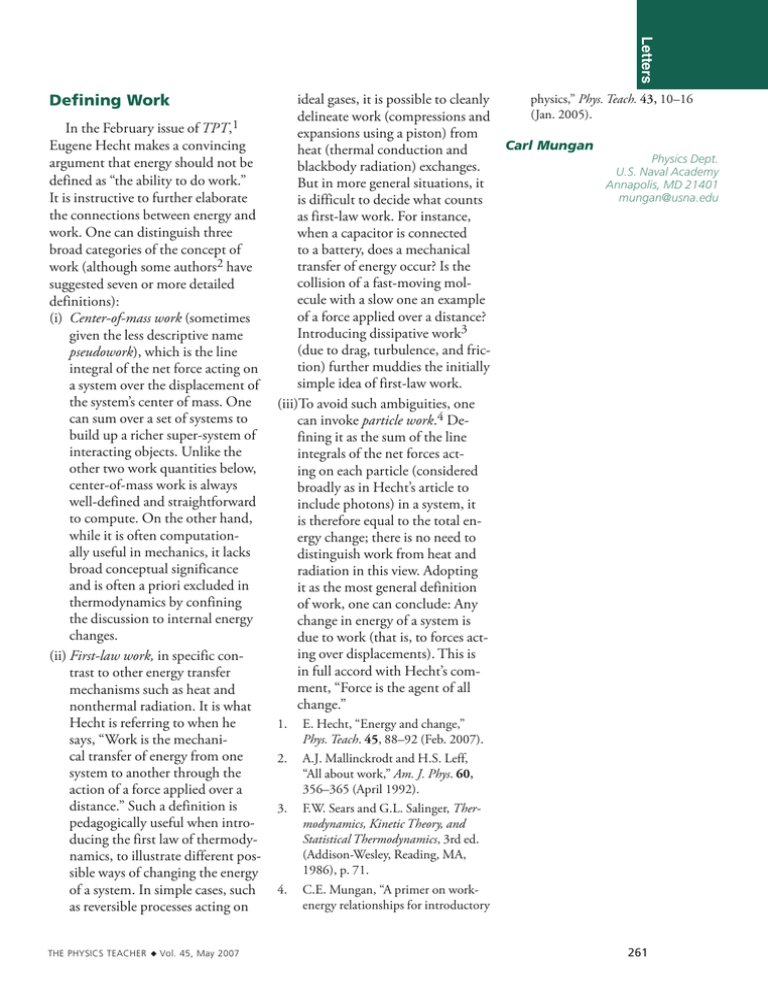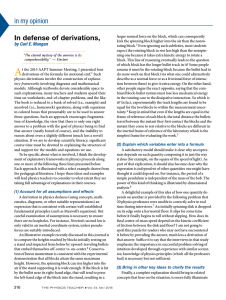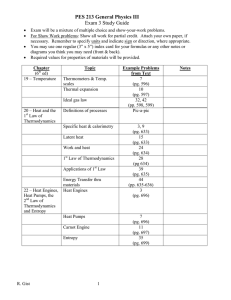Defining Work
advertisement

Letters Defining Work In the February issue of TPT,1 Eugene Hecht makes a convincing argument that energy should not be defined as “the ability to do work.” It is instructive to further elaborate the connections between energy and work. One can distinguish three broad categories of the concept of work (although some authors2 have suggested seven or more detailed definitions): (i) Center-of-mass work (sometimes given the less descriptive name pseudowork), which is the line integral of the net force acting on a system over the displacement of the system’s center of mass. One can sum over a set of systems to build up a richer super-system of interacting objects. Unlike the other two work quantities below, center-of-mass work is always well-defined and straightforward to compute. On the other hand, while it is often computationally useful in mechanics, it lacks broad conceptual significance and is often a priori excluded in thermodynamics by confining the discussion to internal energy changes. (ii) First-law work, in specific contrast to other energy transfer mechanisms such as heat and nonthermal radiation. It is what Hecht is referring to when he says, “Work is the mechanical transfer of energy from one system to another through the action of a force applied over a distance.” Such a definition is pedagogically useful when introducing the first law of thermodynamics, to illustrate different possible ways of changing the energy of a system. In simple cases, such as reversible processes acting on The Physics Teacher ◆ Vol. 45, May 2007 ideal gases, it is possible to cleanly delineate work (compressions and expansions using a piston) from heat (thermal conduction and blackbody radiation) exchanges. But in more general situations, it is difficult to decide what counts as first-law work. For instance, when a capacitor is connected to a battery, does a mechanical transfer of energy occur? Is the collision of a fast-moving molecule with a slow one an example of a force applied over a distance? Introducing dissipative work3 (due to drag, turbulence, and friction) further muddies the initially simple idea of first-law work. (iii)To avoid such ambiguities, one can invoke particle work.4 Defining it as the sum of the line integrals of the net forces acting on each particle (considered broadly as in Hecht’s article to include photons) in a system, it is therefore equal to the total energy change; there is no need to distinguish work from heat and radiation in this view. Adopting it as the most general definition of work, one can conclude: Any change in energy of a system is due to work (that is, to forces acting over displacements). This is in full accord with Hecht’s comment, “Force is the agent of all change.” 1. E. Hecht, “Energy and change,” Phys. Teach. 45, 88–92 (Feb. 2007). 2. A.J. Mallinckrodt and H.S. Leff, “All about work,” Am. J. Phys. 60, 356–365 (April 1992). 3. F.W. Sears and G.L. Salinger, Thermodynamics, Kinetic Theory, and Statistical Thermodynamics, 3rd ed. (Addison-Wesley, Reading, MA, 1986), p. 71. 4. C.E. Mungan, “A primer on workenergy relationships for introductory physics,” Phys. Teach. 43, 10–16 (Jan. 2005). Carl Mungan Physics Dept. U.S. Naval Academy Annapolis, MD 21401 mungan@usna.edu Physics Saves the Day I noticed (with a little chuckle) the note “Hopefully Not Everyday Physics!” by Diane Riendeau in the February issue of TPT (p. 119). A similar thing happened to me (really one of my students) in my early days of teaching. I had been using a 1000ml flask filled with various liquids and a parallel beam light source to demonstrate different focal lengths for those liquids. A couple of days later one of my students came rushing in and declared that I had set him free! It seems that his parents had “grounded” him for smoking after finding a couple of burn marks that looked like a cigarette had been allowed to burn out on a table in front of a picture window. It turns out that a spherical fish bowl, filled with water, was also on the table. Since the window was facing south, the sun rays were the culprit. After performing a home demonstration of the type I had done, the student was exonerated. What more could I ask for as a first-rate learning experience? Lester Evans 8745 Cranston Road Morehead, KY 40351 Levans2@windstream.net Friction and Bouncing Balls After reading the column titled “That’s the Way the Bouncing Ball Spins” in the November 2006 issue of The Physics Teacher,1 my colleague 261




